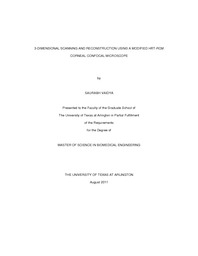
ATTENTION: The works hosted here are being migrated to a new repository that will consolidate resources, improve discoverability, and better show UTA's research impact on the global community. We will update authors as the migration progresses. Please see MavMatrix for more information.
Show simple item record
| dc.contributor.author | Vaidya, Saurabh | en_US |
| dc.date.accessioned | 2012-04-11T20:57:36Z | |
| dc.date.available | 2012-04-11T20:57:36Z | |
| dc.date.issued | 2012-04-11 | |
| dc.date.submitted | January 2011 | en_US |
| dc.identifier.other | DISS-11312 | en_US |
| dc.identifier.uri | http://hdl.handle.net/10106/9612 | |
| dc.description.abstract | The HRT II - Rostock Corneal Module (HRT II-RCM) provides excellent resolution, contrast and optical sectioning capability for cornea imaging. It offers the most detailed views of cornea structure and pathology. However, the major limitation of this microscope is its scanning method. It has a threaded dial on the front side of the microscope which is coupled to the objective, and this dial has to be rotated manually to change the focal plane and to scan through the cornea.The dial is within inches of the cornea. During the scans, manual control causes serious interference and degrades the quality of the corneal images. To overcome this problem, we removed the threaded housing so the objective was made free to move. A Newport TRA25CC Miniature Motorized Actuator with DC Servo motor drive was then attached to the side of the microscope. To couple the actuator to the front section of the microscope, a spring loaded drive shaft was used which was connected to the front housing. The actuator was connected to Newport's Single axis Motion Controller (SMC100CC), which was interfaced to a PC. A Windows based software was developed to control and display the focal plane position. Also, the HRT-RCM scan head was mounted on a slit lamp stand to facilitate the alignment process. Finally, a thin silicon washer was placed on the Tomocap to eliminate the reflections that can interfere with superficial epithelial imaging. . To assess the feasibility of performing quantitative full-thickness corneal imaging using this prototype machine, some preliminary tests were carried out. Both eyes of two New Zealand white rabbits were repeatedly scanned from endothelium to epithelium at a constant speed of 60 micrometers/sec, and images were continuously acquired using HRT streaming software. A custom - developed program was rewritten to read the resulting image sequence (".vol" file) from the confocal microscope. The dataset was read into this in-house software for interactive 3-D viewing and measurement of sub-layer thicknesses. Using this software, the Z - position of each image was accurately calculated from the lens speed and encoded time in the header of each image frame. In four corneas, the keretocyte nuclei were counted manually using Metamorph software. The mean epithelial, stromal and corneal thickness measured using the modified HRT-RCM were 46.57 ± 5.25 microns, 326 ± 23.51 microns and 373.27 ± 24.93 microns (n=4 corneas), with average coefficients of variation (CV) for repeated scans 8.16%, 2.05% and 2.28% respectively. The corneal thickness of the same cornea was measured using Ultrasonic Pachymetry (UP) also as 374 ± 16.95. The mean overall keratocyte density measured in vivo was 42,807± 676 cells/mm3 and CV = 1.58% (n =4 cornea), which was in good agreement with the literature. Also, a gradual decrease in density from the anterior to posterior cornea was also noted which is also in agreement with the numbers published in previous literatures. The hardware and software modifications to the HRT-RCM allow high resolution 3-D image stacks to be collected from the entire cornea in vivo automatically, making the scanning procedure hands free. Using the modified CMTF program, these datasets can be used for interactive visualization of corneal cell layers, as well as quantitative ssessment of sub-layer thickness. Because of the high image contrast, the modified HRT-RCM also allows for depth dependent keratocyte density measurements from the cornea in vivo. Overall, the modifications significantly expand the capabilities of the HRT-RCM for quantitative corneal imaging. | en_US |
| dc.description.sponsorship | Petroll, Matthew | en_US |
| dc.language.iso | en | en_US |
| dc.publisher | Biomedical Engineering | en_US |
| dc.title | 3-dimensional Scanning And Reconstruction Using A Modified HRT-RCM Corneal Confocal Microscope | en_US |
| dc.type | M.S. | en_US |
| dc.contributor.committeeChair | Petroll, Matthew | en_US |
| dc.degree.department | Biomedical Engineering | en_US |
| dc.degree.discipline | Biomedical Engineering | en_US |
| dc.degree.grantor | University of Texas at Arlington | en_US |
| dc.degree.level | masters | en_US |
| dc.degree.name | M.S. | en_US |
Files in this item
- Name:
- Vaidya_uta_2502M_11312.pdf
- Size:
- 854.0Kb
- Format:
- PDF
This item appears in the following Collection(s)
Show simple item record


